
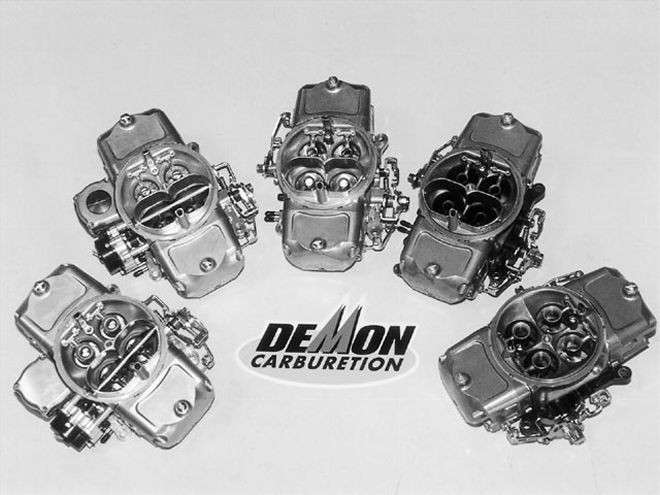 Big carb, little carb, in-between carb-which one do you run? The five shown here range from a 625 Road Demon to the annular booster 950 Race Demon drag-race special.
Big carb, little carb, in-between carb-which one do you run? The five shown here range from a 625 Road Demon to the annular booster 950 Race Demon drag-race special.
There's an old saying in the racing world: If some is good, too much is just enough. In the world of four-barrel performance carbs, the first question is how big should you go. The bottom line in power production is airflow, and the more airflow an engine has, the more potential there is to make power. Does this mean all it takes to put really big numbers on the board is bolting on the biggest carb you can get your hands on? No. Carb capacity has to be matched to the airflow capacity of the rest of the engine's flow system, including the heads, intake, exhaust, and camshaft specs. While it's true that too small a carb on an otherwise airflow-hungry engine will soak top-end power, the other side of the equation is that too large a carb will make for a larger venturi (the opening where the fuel enters the air to create an atomized mixture), which in turn will reduce air speed (or velocity) through the carb's booster, hurting low-end response and atomization.
Carburetors are rated by an airflow number: 650, 750, 850, and so on. The number is the carb's flow capacity, rated by number of cubic feet per minute (cfm) of air that will go through the carb when wide open. This air just won't go flying through the carb by itself, however; there must be a pressure differential, with less pressure on the throttle side of the carb than on the air-cleaner side for flow in the normal direction to occur. With a huge pressure differential, a correspondingly large volume of air will flow through the carb. Conversely, if the pressure differential is zero, no air will go through.
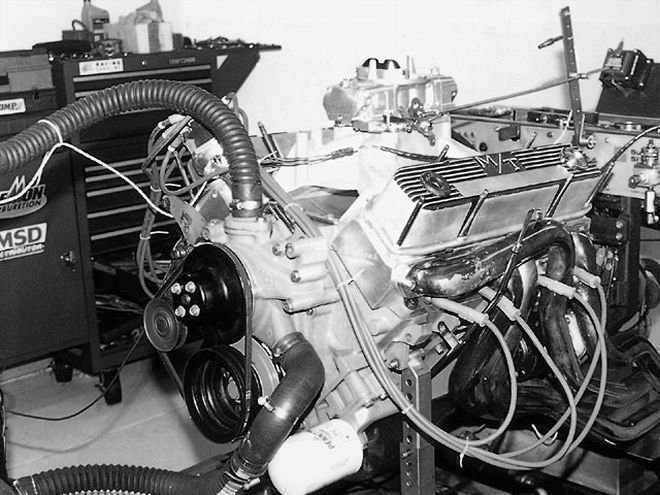 We ran all the carb tests on our solid street roller, Edelbrock-headed 440, feeding into Westech's Superflow dyno to see what they would do. Headers are tti 2 inch.
We ran all the carb tests on our solid street roller, Edelbrock-headed 440, feeding into Westech's Superflow dyno to see what they would do. Headers are tti 2 inch.
To provide meaningful comparative ratings on carb airflow, a standard pressure drop was needed to rate the cfm of carburetors. The industry adopted a standard of 1.5-inch Hg pressure drop across the carb for rating four-barrel carbs and a higher figure of 3.5-inch Hg pressure drop to rate two barrels. The standards are different for the two carb configurations based on a belief that these twin pressure drops most accurately represent the operating conditions found in passenger car engines under running conditions. In actual use, the engine provides the pressure differential to prompt airflow through the carb via the action of the pistons and the valves. A performance engine creates a certain amount of airflow based on its displacement, volumetric efficiency, and maximum rpm of operation. There are formulas for calculating the engine's airflow requirements based on these parameters, which will give a good ballpark of the carb capacity required, but is that the end of the story?
For example, let's take a rebuilt .030-inch-over 440 Chrysler big-block. Plugging into a pumping efficiency formula, we get an airflow requirement of 774 cfm based upon a displacement of 446 ci at 6,000 rpm, assuming we have a highly developed performance engine with a volumetric efficiency of 100 percent. Therefore, the mathematical airflow demand of the engine can be delivered by a 774-cfm four-barrel carb operating under a peak manifold vacuum of 1.5-inch Hg at WOT. Maintain that 1.5-inch Hg atmospheric depression in the intake and the 774-cfm carb will deliver the airflow demanded. However, a larger carb will satisfy this airflow demand, yet at the same time allow the manifold's peak vacuum level to drop to less than 1.5-inch Hg and likely result in the engine aspirating more air and producing more peak power.
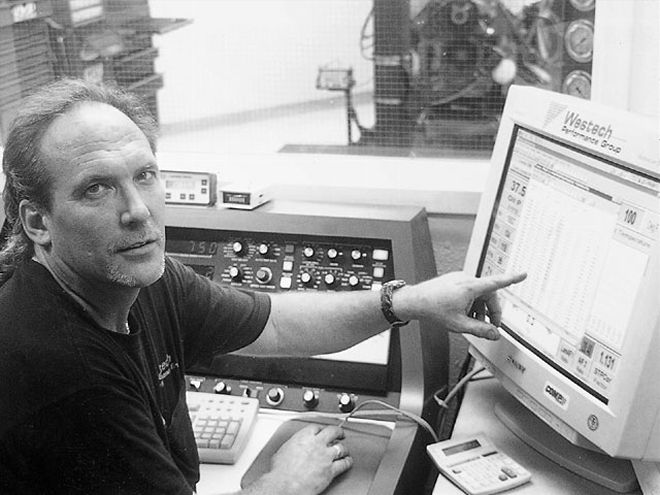 Steve Brule, Westech's dyno operator, was the key to making this test work, interpreting the info from the dyno so the air/fuel ratio of each carb could be calibrated for max power.
Steve Brule, Westech's dyno operator, was the key to making this test work, interpreting the info from the dyno so the air/fuel ratio of each carb could be calibrated for max power.
How much larger can you go before drivability suffers? That depends on the intended use and ultimately the weight and driveline in the car. Steep rear gears and a four-speed or high-stall converter in a lighter car is the most forgiving situation favoring the larger carb choice. Conversely, a heavier, higher-geared car used mainly for the streets and seldom wound out to peak rpm will typically be happier with a more conservative carb choice
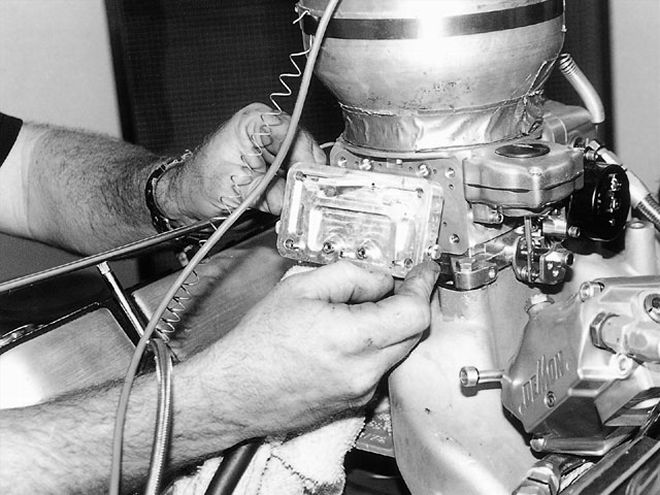 We jetted each carb to get the most out of it. Time-consuming? Yes, but it's the only way to get a meaningful comparison. Output surged more than the small difference in rating would suggest.
We jetted each carb to get the most out of it. Time-consuming? Yes, but it's the only way to get a meaningful comparison. Output surged more than the small difference in rating would suggest.
Just to see how all this theory works out in practice, we rounded up an assortment of new Demon carbs, ranging from the vacuum secondary 625-cfm Road Demon to the professional-level 950-cfm annular discharge booster Drag Race Demon and put them through the paces at the Westech dyno facility. Our test engine is a stout '71 street 440 Six Pack engine, bored .030-inch over and fitted with replacement TRW forged Six Pack pistons, out-of-the-box Edelbrock heads, Tube Technologies Inc. (tti) 2-inch headers, a Competition Cams 280/286 duration street roller cam, matched Comp valvesprings, and a Comp 1.5:1 roller rocker valvetrain (PN 1321). The engine is capable of output in the 550hp range, while maintaining 9 inches of vacuum at idle. To minimize intake restriction in this test, we decided on a single-plane intake and settled on Mopar Performance's M-1. The M-1 ranks as the highest-flowing, single-plane intake we've tested to date for a standard-port, big-block Mopar, at an average runner flow of 289 cfm out of the box. This one was port-matched and ported in the plenum for an average runner flow of 316.5 cfm.
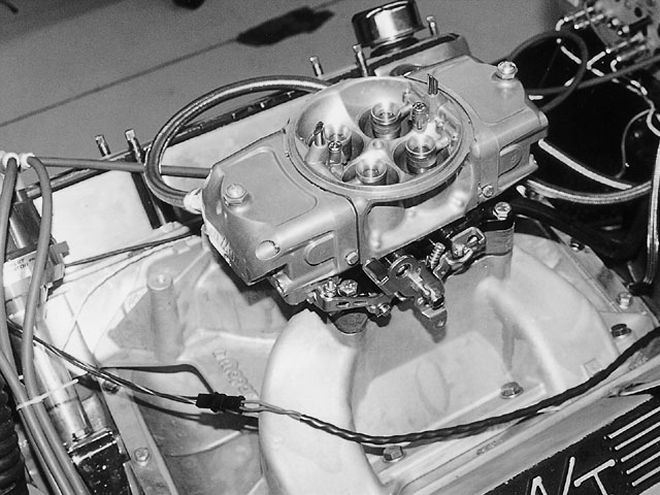 Bolted onto the engine, the Race Demon looked racy with no choke horn and radiused air entries.
Bolted onto the engine, the Race Demon looked racy with no choke horn and radiused air entries.
Show Time
For our baseline test, we bolted on the baby of the lineup, the Road Demon 625 carb. The Road Demon is an entry-level street-performance piece-as the name suggests-set up for street use. Featuring an automatic electric choke mechanism and vacuum secondaries, the Road Demon makes a nice street piece, but has amenities usually found on racier carbs, such as four-corner idling and replaceable main jets at both ends. On this racy big-block, however, it seemed way too small.
Though we would test a wide range of carb sizes, our numbers would be meaningless unless we optimized each carb to provide an ideal air/fuel ratio. As we would do with each carb, the Road Demon was first run at a static state on the dyno at near-peak torque rpm. Dyno operator Steve Brule analyzed the air/fuel ratio based on feedback from the dyno's air and fuel flow meters; lambda sensor; and calculated brake-specific, fuel consumption figures. Following the static tests, a number of partial pulls were made and the jetting changed to optimize the carb's air/fuel ratio for our 440's specific combination. In other words, we made sure each carb's mix was bang-on for making as much power as it had in it.
The Demon 625 turned in surprisingly good numbers, with peak horsepower coming in at 526.7 at 5,700 rpm and peak torque showing 539.7 at 4,500 rpm. Our 440 was making good power, but the manifold vacuum numbers showed the 625 carb was restrictive on this large, powerful engine, with 1.7-inch Hg recorded at 6,100 rpm. Based upon the intake vacuum readings alone, it was clear there was power to be had by going bigger.
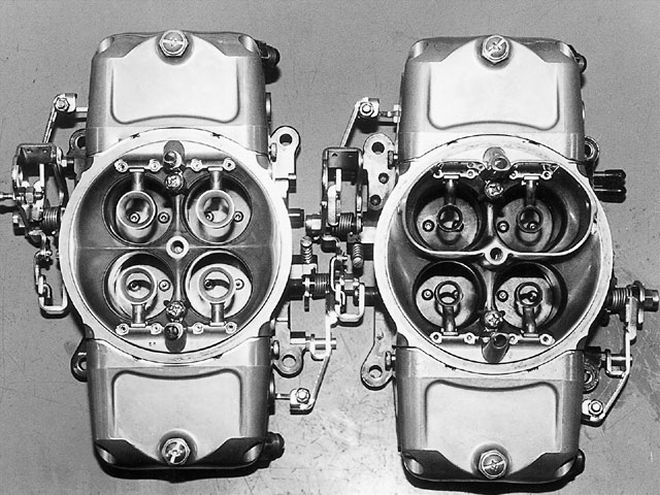 Our final move was to the 950 Race Demon (left). This carb is equipped with annular discharge boosters, which help torque and low-end response with the large carb. Note how much larger the boosters (left) are than on the 850 Speed Demon (right). Annular boosters have a series of discharge holes all around the inside diameter, rather than the single discharge nozzle in a conventional booster.
Our final move was to the 950 Race Demon (left). This carb is equipped with annular discharge boosters, which help torque and low-end response with the large carb. Note how much larger the boosters (left) are than on the 850 Speed Demon (right). Annular boosters have a series of discharge holes all around the inside diameter, rather than the single discharge nozzle in a conventional booster.
It's Called the 650
Next up was the 650 Speed Demon carb, a small vacuum secondary carb unit similar to the Road Demon. The Speed Demons are street/strip carbs, coming with or without a choke, but with the choke horn cast in place on all of them (the choke can be added as an accessory). Vacuum-secondary Speed Demons feature the choke installed and a cap on the vacuum diaphragm housing, allowing for easy access for changing the secondary opening spring.
We didn't expect much change from the 625 carb by going to the 650, but the numbers were surprising, with power moving up to 543.2 hp at 5,800 rpm and 546.4 lbs-ft at 4,500 rpm. The manifold vacuum told much of the story, with WOT intake vacuum dropping to .9-inch Hg at 6,100 rpm-a drastic reduction-for a gain of 16.5 peak horsepower. With this carb, the air consumption reading on the dyno showed the 440 was taking in an additional 21 cfm of air. Is it possible that the actual flow difference between the two carbs is much more than the 25 cfm implied?
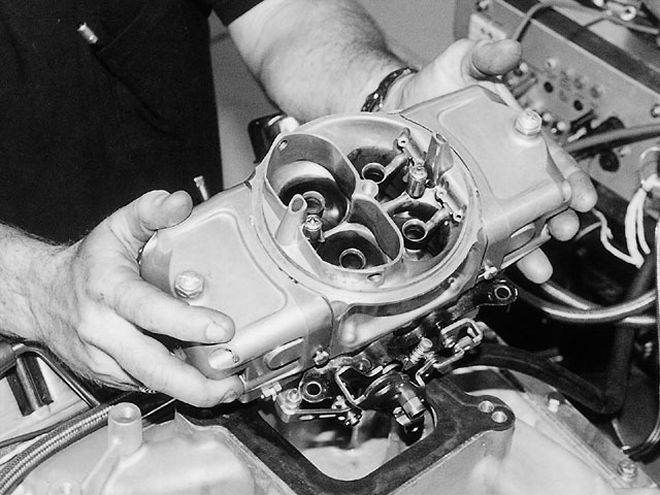 The Race Demon is a pro-level carb with changeable air bleeds for the low- and high-speed circuits (arrows), making tuning choices nearly unlimited.
The Race Demon is a pro-level carb with changeable air bleeds for the low- and high-speed circuits (arrows), making tuning choices nearly unlimited.
Movin' Up
With the 650 carb cutting the intake vacuum in half, a big chunk of the potential gain from reducing intake restriction had been realized, but we felt there was more to be had. Our next move was to step up to the popular 750 size, a favorite carb configuration for street/strip engines and the size closest to the cubic feet per minute given by the formula. Again, we went with a Speed Demon series of carburetor, but this time used a mechanical secondary unit (a vacuum secondary version is also offered). Unlike the 650, the choke plate is omitted from the mechanical secondary 750, but the carb has provisions to add a choke.
The 750 did its job: added horsepower over the entire test range, although the intake vacuum was down slightly from the previous test with the 650. The stats came in at 552 hp at 6,000 rpm and 552.5 lbs-ft at 4,500, pushing our engine beyond the magic 550hp number with a gain of 9 hp and making peak horsepower 200-rpm higher. Airflow readings showed the 750 was allowing the 440 to ingest 4-cfm more air than in our previous test. Output down near the bottom end of the test range was never significantly off from the numbers turned in with the smaller carb, and after 3,500 rpm, the 750 had a decided advantage.
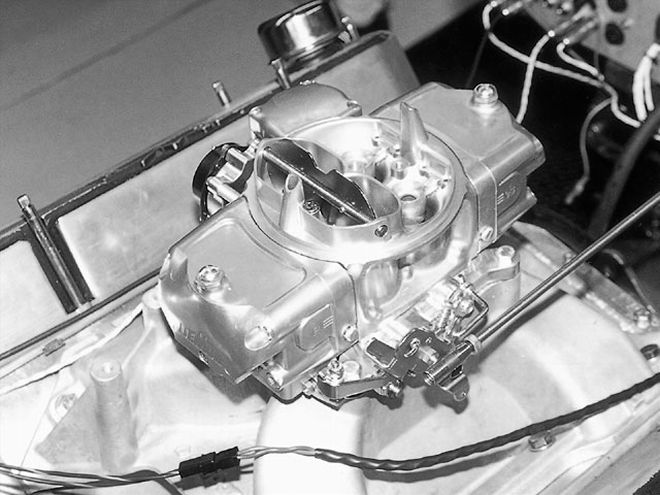
The 850
So far, our 440 responded favorably each time the carb size was stepped up. Next to find its way onto the manifold was the Speed Demon 850 mechanical secondary, a carb size that has long been a favorite of more serious street runners and drag cars. The 850 is the carb that most closely fit the manufacturer's recommendation for a high-output big-block such as ours. The 850 mechanical secondary had been our choice for carboration in previous dyno tests of engines in this performance range. How would it stack up against the smaller carbs?
We dialed in the jetting and it wasn't long before the big carb showed its worth, belting out 560.4 hp at 5,900 rpm and making 557.3 lbs-ft of torque at 4,600 rpm. The bigger carb bagged another 8 hp up top, while not materially detracting from output at the lower part of our test range. In fact, midrange torque was up compared to the 750. Manifold vacuum was down significantly with the 850 carb, and according to the flowmeter, the 440 was able to pull in another 8 cfm of air. The 850 is a good match for this engine.

The Race Demon
Our next carb was the 950 drag race calibrated Race Demon, a professional-level carb. The Race Demon isn't cheap, but it has the features to make it a serious performance piece. Unlike the Speed and Road Demons, the Race Demon has replaceable air bleeds on both the high- and low-speed circuits, for super-fine-tuning of the fuel curve. The version we ran also had annular discharge booster venturis, which use a series of discharge holes around the inside diameter of the large booster, dramatically increasing the booster signal and atomization for such a large carb. This helps boost low-end torque, where the large size would often penalize output and response.
The 950 boosted peak output to 565.7 hp at 6,100 rpm and torque to 564.6 at 4,600 rpm, both sets of numbers up on the 850's results. The engine was indeed taking in more air with the 950 carb, with air consumption edging up by another 3 cfm. We were clearly reaching the practical limits on carb-size requirements for this street combo, but it seemed the engine would take in more air with a spacer, better using the large carb. With the 950's annular boosters, we figured even with the larger plenum volume, the 440 should retain its outstanding torque output at the lower end.
We sandwiched a Barry Grant 1-inch laminated spacer between the Race Demon and our M-1 intake and prepared for another pull. The engine definitely liked it, with power now climbing to 571.8 hp at 6,000 rpm and torque also going up, with 568.5 lbs-ft now on tap at 4,500 rpm. In fact, with the spacer, our 440 actually gained torque throughout the curve; credit the Race Demon's annular boosters for this.
All in all, there was a great deal of power to be found by matching the carb size to the engine's actual requirements rather than the equation. From the smallest to the largest, there was a full 45hp range in output-enough to really feel the difference or to win or lose a race. While bigger isn't always better, if you've got the motor enough to back it up, it usually is.
DYNO RESULTS